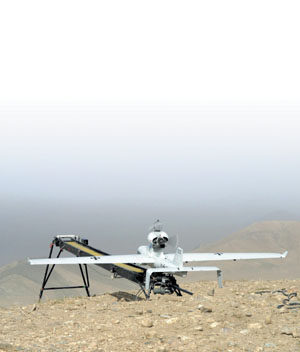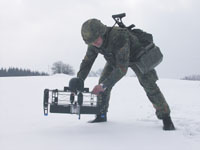Silent Eyes Guard Peacekeepers
 |
| The Luna lightweight unmanned aerial vehicle (UAV) has flown nearly 1,000 peacekeeping and surveillance missions in Bosnia, Kosovo and Afghanistan. With the ability to change quickly between optical and radar sensor packages, the Luna is a major tactical asset for the German army. |
A family of advanced lightweight reconnaissance drones is enhancing the situational awareness of German army units in Afghanistan and Kosovo. Easily transported in ground vehicles, the aircraft feature an automated flight control and navigation system that does not require skilled pilots to operate and can be rapidly assembled. Designed for mobility and a minimal logistics trail, the aircraft can operate from forward areas without the need for a runway.
Unmanned aerial vehicles (UAVs) are the eyes of a modern army. New manportable tactical UAVs now allow small unit commanders to locate enemy positions before moving in to engage them. This capability not only increases the survivability of forces in a battle zone but also contributes vital intelligence that can be immediately acted upon.
The German army is one of the many NATO nations that has acquired a UAV capability in the past few years. Its tactical observation platforms consist of the Luna and Aladin UAVs, manufactured by EMT, Penzberg, Germany. The company is one of the primary suppliers of unmanned reconnaissance aircraft to the German army, explains a senior EMT official.
In service since 2000, Luna UAVs are the main tactical observation system used by German ground forces. The Luna is a high-performance motor glider. It uses a small gasoline engine to reach and maintain altitude, but its onboard sensors cut the engine off when it encounters an updraft or reaches its operational height. This gliding technique allows an operational endurance of up to four hours and offers a stealth feature because it can fly silently over a target.
A small crew of soldiers can assemble, launch and control the lightweight craft, which can be removed from its box and readied for flight in 15 minutes. It is launched from a bungee-cord powered ground catapult. During setup, the aircraft’s mission is planned in a mobile ground control station, which can be installed in a variety of armored and all-terrain vehicles. A mouse is used to click waypoints on a digital map to create a path for the aircraft to follow.
Luna features an autonomous obstacle and terrain avoidance system that checks and maintains its altitude with each waypoint. If a point is logged-in that is out of the groundstation’s line of sight, the system will warn the crew to increase the altitude or move the site. “If you place a waypoint on top of a mountain and another behind it, the aircraft wouldn’t know there is a mountain between both points. But the software would advise the operator to change the waypoint altitude and location,” the official explains.
When mission planning is complete, the information is sent to the UAV via a datalink and stored in its onboard memory. The datalink has a range of approximately 80 kilometers (50 miles). After an electronic preflight check and a physical inspection, the Luna’s engine is remotely started. “The only thing the launcher team has to do manually is pull the safety pin from the launcher [to release the aircraft],” he says.
Although the Luna can fly without any human intervention, its operators can redirect it if mission requirements suddenly change or if its onboard sensors have detected a new target. The operator can override the pre-planned mission and circle the craft around the target so the camera can lock onto it. Then Luna can continue on its pre-programmed flight, or the operator can change the waypoints during flight.
The UAV does not require a runway for landing. It stops its engine and deploys a parachute over the recovery site. If the Luna loses power or runs out of fuel while in flight, it can glide back to its landing site or an alternate area guided by a digital map or its navigational camera.
A pilot is not needed to fly Luna, unlike with larger UAVs. The craft’s autonomous navigation and landing systems permit it to be controlled by troops with only several weeks of training on the system. The lightweight launcher and mobile ground control center permit the aircraft to operate in rugged areas with little or no logistics requirements.
The Luna’s payload bay accommodates a variety of modular sensor packages that can be quickly switched or replaced in the field. The standard payload consists of a stabilized platform containing one infrared and four daylight video cameras that pan and tilt to track a target. The aircraft has three other cameras for navigation and control purposes, and images from all seven cameras can be fed simultaneously to the groundstation. The operator can have all of the images on one screen in separate windows, or individual operators can monitor specific images on different screens.
EMT also has developed a compact synthetic aperture radar (SAR) sensor for Luna. The official maintains that at only 4 kilograms (8.8 pounds) it is the lightest SAR sensor available. The new lightweight SAR has a resolution of 50 centimeters (20 inches) and uses the same datalink as the optical sensors.
The UAV has conducted nearly 1,000 missions over Kosovo, Bosnia and Afghanistan since it entered service in 2000. The German forces in Afghanistan began providing reconnaissance services for the Canadian troops based there because the harsh environment, high altitudes and low visibility had disabled or destroyed all of the Canadian forces’ UAVs.
Other nations have expressed interest in Luna’s capabilities, and EMT recently conducted flight tests in a NATO nation and in the Middle East. Nations can buy several Luna systems for the price of many other individual UAVs, the company official notes. Because the system can fit into a jeep-size vehicle, it can be transported by C-130 aircraft and deployed by CH-53 helicopters, he says.
EMT’s engineers applied experience gained from Luna to the company’s newest aircraft, the Aladin mini reconnaissance drone. Designed to provide commanders with an over-the-hill observation capability, the UAV is manportable and can easily fit inside almost any military vehicle, the official says. For example, a tank unit’s commander could send one to scan a town for enemy positions before moving in.
The fully assembled UAV weighs only 3 kilograms (6.6 pounds) and is hand-launched by being thrown into the air. The manportable ground control station features the same mission planning and flight control software used for Luna. However, the aircraft’s route is planned with a touch-sensitive tablet computer combining a monitor and controls instead of with a mouse. The backpack unit carries a datalink, a digital data recorder and an extra lithium polymer battery for the UAV.
Aladin is powered by an electric motor and uses the same powered gliding technique as Luna. To land, the aircraft cuts off its engine several meters off the ground, pulls up into a deep stall configuration and drops.
Like Luna, Aladin uses a digital autopilot and can fly autonomously once its route has been planned. The sensor package consists of four daylight video cameras or an infrared sensor. It has a flight endurance of more than 45 minutes. Even with the engine running, the official maintains that it is very hard to detect at its operating altitude of 100 meters (330 feet). “If you don’t accidentally look up, you won’t notice that somebody’s watching you,” he says.
In 2003, six Aladin UAVs were field tested with the German NATO forces in Afghanistan. Company engineers are incorporating lessons learned from those operations into the first major production order. The official explains that the German army plans to purchase 100 of the mini UAVs beginning in 2005.
The company also is working on two experimental UAVs designed for use in urban operations. Mikado is a small manportable aircraft designed to provide troops with data about enemy positions around buildings. It has an operational range of 500 meters (1,650 feet) and an endurance of 20 minutes. It is equipped with a daylight or low-light video camera and a simple datalink to a manportable ground control station. Powered by an electric engine, Mikado—like all of EMT’s UAVs—is capable of fully autonomous flight, but its operational area is too small to require the digital maps and waypoints, the official says.
 |
| EMT is developing new technologies such as the Fan Copter to help troops operate in urban areas. Capable of hovering or quietly sitting on a rooftop and monitoring a situation with its video camera, this small experimental UAV is being considered for use by the German army. |
Although the German army is evaluating both aircraft, there is a possibility that it will reconsider the initial specifications and operational requirements, the official warns. Some uncertainty exists about which of the two UAVs the army may select, but it is favoring the Fan Copter because of its ability to hover and perch, he offers.
Work is underway on a long-range UAV for German navy maritime patrols. With a takeoff weight of 130 to 150 kilograms (286 to 330 pounds), the X-13 is EMT’s largest platform to date. It will have a range of 200 kilometers (125 miles) and an endurance of up to 6 hours and will fly at an altitude of 3,050 meters (10,000 feet). The larger size of the aircraft will permit a larger all weather sensor package consisting of a SAR, optical sensors and a maritime radar.
The X-13 will require a civil certification because it is designed to operate in civilian airspace. It will be equipped with a radar transponder, a system to detect and avoid other aircraft, and a radio to allow the operator to communicate via the UAV to civilian air traffic controllers.
The official notes that the company already has built a half-scale model, and a full-scale prototype for taxi testing is under construction. Designed for use in a naval environment, the X-13 can be launched from a ship by catapult and will land in a net. The German army already is using this net capture method with Luna UAVs. The X-13 also will have software that will allow it to track and land on a moving vessel in seas with waves up to 3.6 meters (12 feet) high.
Web Resources
EMT: www.emt-penzberg.de/en/index.htm
NATO: www.nato.int




Comments